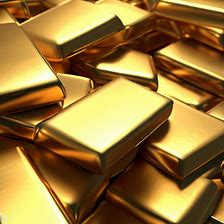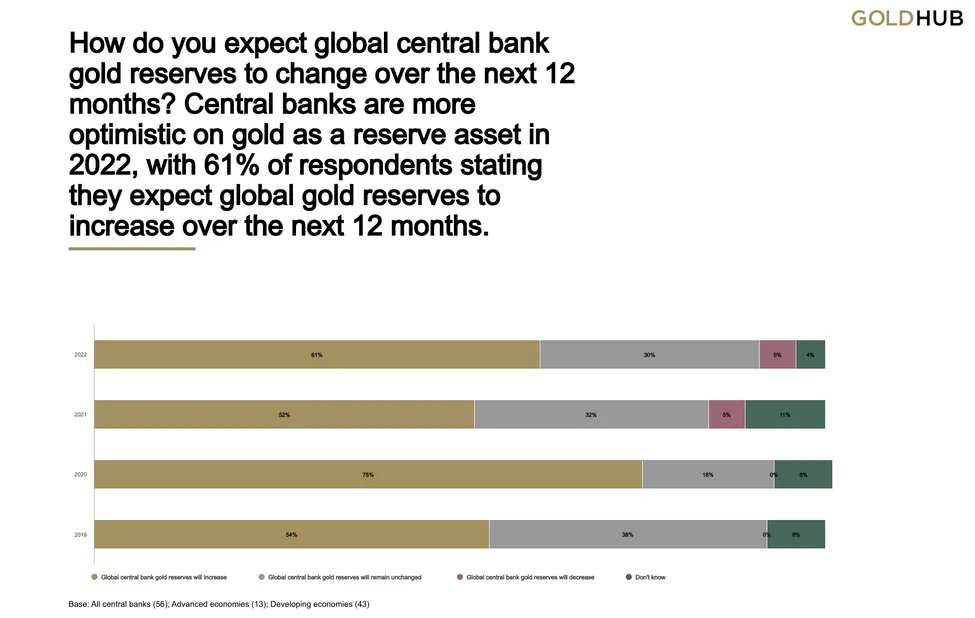The 10+1 central banks with the largest gold reserves in the world

The global central bank's gold reserves exceed 35,715 tonnes, about a fifth of all gold ever mined. Which countries hold the most metal?
Central banks buy gold for a variety of reasons: to mitigate risk, hedge against inflation and promote economic stability. In a mid-2022 survey, the World Gold Council (WGC) said 61% of central bankers polled expect global gold reserves to increase in the next 12 months. Nearly three-quarters of respondents cited the precious metal's "long-term store of value" as a driving factor in gold purchases.
Central banks added 1,135.7 tonnes of gold to their vaults in 2022, signaling a significant demand reversal after a 10-year low of 255 tonnes recorded in 2020 as high prices curbed buying activity.
Central banks are expected to continue as net gold buyers advance. 25% of respondents to the WGC survey indicated plans to increase their gold reserves, up from 21% a year earlier. And for the second year in a row, no respondents indicated that their institution is planning to reduce its gold reserves.
However, the WGC notes that economic and geopolitical uncertainty related to the COVID-19 pandemic and Russia's war in Ukraine could create a "divide between central bank respondents in advanced economies and those in emerging markets and developed economies" .
Which central banks hold the most gold?
The quantities are indicated MT, i.e. metric tons.
1. United States 8,133.46 MT
When it comes to the largest gold reserves, the US central bank is number one with 8,133.46 tons. Valued at more than $474 billion, a large percentage of US gold is held in "deep deposits" in Denver, Fort Knox and West Point.
As the U.S. Treasury explains, deep storage is “that portion of the U.S. government-owned reserve of gold bullion that the Mint maintains in sealed vaults that are reviewed annually by the Office of the Inspector General of the Department of Treasury and consists mainly of gold bars”. The remainder of U.S. property reserves are held as working stock, which the country's mint uses as raw material to strike coins authorized by Congress
2. Germany 3,355.14 MT
The Bundesbank, Germany's central bank, currently owns 3,355.14 tons of gold, which is less than half the amount the United States has accumulated. Like many of the central banks on this list, the German national bank stores more than half of its shares in overseas locations in New York, London and France.
The Bundesbank's foreign gold reserves came into question in 2012, when Germany's Federal Audit Office, the Bundesrechnungshof, was openly critical of the Bundesbank's gold audit.
In response, the German bank issued a public statement defending the safety of foreign banks. Privately, the Bundesbank then began the arduous process of repatriating its gold stocks to German soil. By 2016, more than 583 tonnes had been transferred back to Germany.
Nearly half of Germany's gold reserves are stored in Frankfurt, while more than a third are in New York; an eighth of its holdings are in London, and a minuscule amount is held in Paris.
3. Italy 2,451.84 MT
Banca d'Italia, the national bank of Italy, began hoarding its gold in 1893, when three separate financial institutions merged into one. From there, its 78 tons slowly grew to the 2,451.84 tons the country now possesses.
Like Germany, Italy stores part of its reserves offshore. In total, 141.2 MTs are located in the UK, 149.3 in Switzerland and 1,061 are held in the US Federal Reserve. Italy hosts 1,100 tons of gold nationwide. Most of this gold was harvested when there was partial convertibility of the dollar into gold through the large trade surpluses we created with the US.
4. France 2,436.75 MT
The Banque de France keeps all 2,436.75 tons of its gold reserves on hand. The precious metal is kept in the bank's secure underground vault, dubbed La Souterraine; it is located 27 meters below street level. The La Souterraine Gold Vaults are one of four International Monetary Fund designated gold vaults.
According to Investopedia, the collapse of the Bretton Woods gold standard was partly due to former French President Charles de Gaulle, who "called the US bluff and started exchanging dollars for gold from reserves at Fort Knox." At the time, US President Richard Nixon "was forced to take the United States off the gold standard, ending the automatic convertibility of the dollar into gold."
5. Russia 2,301.64 MT
The Bank of Russia is the official central bank of the Russian Federation and owns 2,301.64 tons of gold. Like France, Russia's central bank has chosen to store all of its physical gold domestically. The Bank of Russia stores two-thirds of its gold reserves in a bank building in Moscow, and the remaining one-third in St. Petersburg.
Most of the yellow metal is in the form of large standard gold bars of varying weight weighing between 10 and 14 kilograms. There are also smaller bars on site weighing up to 1 kilogram each.
Russia, which is the third largest gold producer by country, has been a steady buyer of the precious metal since around 2007, with sales increasing significantly between 2015 and early 2020. However, Russian refineries have been forbidden to sell gold bars in the London market. following the country's invasion of Ukraine. Western sanctions also include freezing about half of Russia's gold reserves.
6. China 2010.51 MT
The central bank for mainland China is the People's Bank of China (PBoC), headquartered in Beijing. The National Financial Institution stores 2,010.51 tons of gold, most of it purchased since 2000. In 2001, the PBoC had 400 tons of gold in reserve, but in less than two decades, the total has increased by 487%.
The PBoC issues the Panda gold coin, which was first created in 1982. The Panda coin is now one of the top five gold coins issued by a central bank. It is in the ranks of the American eagle, Canadian maple leaf, South African Krugerrand and Australian gold nugget.
7. Switzerland 1,040 m
The seventh largest central bank gold reserve is held by the Swiss National Bank. Its 1,040 tons of gold are owned by the Swiss state, but the central bank manages and maintains the reserve.
After years of opacity regarding the country's gold hoard, the Swiss Gold Initiative, or Save our Swiss Gold campaign, was launched in 2011.
The publicity culminated in a national referendum in 2014, asking citizens to vote on three proposals. The first was a mandate for all reserve gold to be physically held in Switzerland. The other two concerned the central bank's ability to sell its gold reserves, along with a decree requiring 20% of the Swiss bank's assets to be held in gold.
The referendum was unsuccessful, but prompted the bank to be more transparent. In a 2013 release, the central bank reported that 70% of its gold reserve was held domestically, 20% at the Bank of England and 10% at the Bank of Canada.
8. Japan 845.97 m
It is difficult to obtain public information about the Bank of Japan's gold reserves. In 2000, the island nation held about 753 tons of the yellow metal. In 2004, the Bank of Japan's gold deposit had grown to 765.2 tonnes, and remained at that level until March 2021, when the country bought 80.76 tonnes of gold.
9. India 787.40 m
The Reserve Bank of India is another central bank that has increased its holdings in recent years. It started adding to its gold assets in 2017; however, most of his signings have been in the past three years.
While more than half of its gold is held overseas in secure custody at the Bank of England and the Bank for International Settlements, around a third of this gold is held domestically.
10. Netherlands 612.45 m
Rounding out this list of major central bank gold reserves is the Dutch National Bank (DNB), the central bank of the Netherlands. Like Switzerland, the Dutch central bank stores up to 38 percent of its gold in Canada's national reserve. Another 31 percent, in the form of 15,000 gold bars, is kept in a home vault, while the remaining 31 percent is in the Federal Reserve Bank of New York.
In a report, the DNB describes gold as the ultimate safe haven. “Central banks like DNB have therefore traditionally had a lot of gold in stock. After all, gold is the ultimate reserve – the anchor of confidence for the financial system,” it reads. “If the whole system collapses, the gold supply provides a guarantee to start again. Gold gives confidence in the strength of the central bank's balance sheet. This gives a feeling of security.
The “+1”
*11. International Monetary Fund 2,814.1 MT
The gold reserve held by the International Monetary Fund is the third largest in terms of size. The large gold reserve was mainly accumulated during the founding of the international organization in 1944.
In that inaugural year, it was decided that "25 percent of initial dues and subsequent dues increases were to be paid in gold."
Since 1944, the International Monetary Fund has added gold through the repayment of member countries' debts. Nations can also exchange gold for another member country's currency.
Data updated as of April 2023

Thanks to our Telegram channel you can stay updated on the publication of new articles from Economic Scenarios.
The article The 10+1 central banks with the largest gold reserves in the world comes from Scenari Economici .
This is a machine translation of a post published on Scenari Economici at the URL https://scenarieconomici.it/le-101-banche-centrali-con-maggiori-riserve-auree-al-mondo/ on Thu, 10 Aug 2023 14:04:09 +0000.



